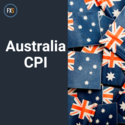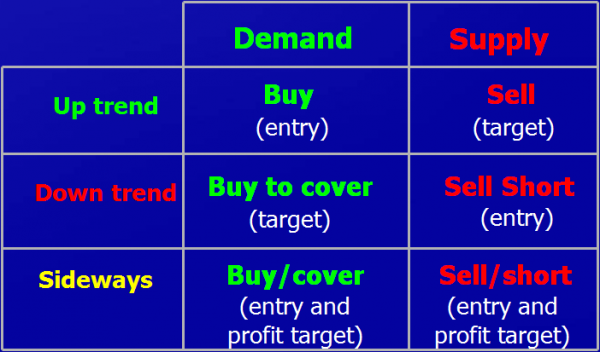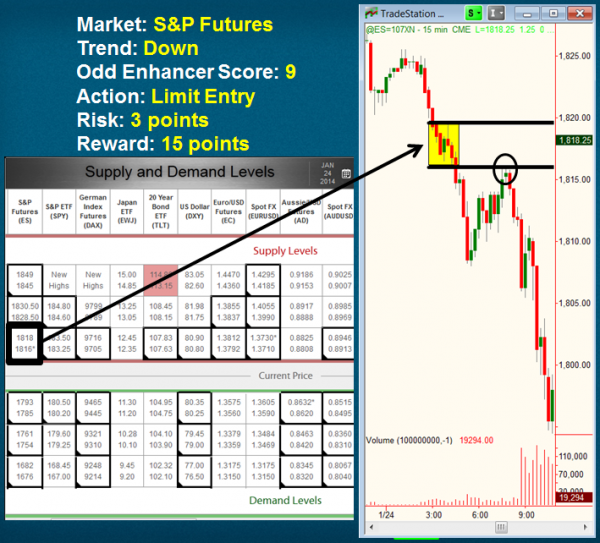![]()
Once in a while, I will get an email from someone saying, “I like your supply and demand strategy but what strategy should I use in trending markets?” This person thinks the strategy is only for markets going sideways where they use supply and demand to pick tops and bottoms. What this person doesn’t realize is that we use supply and demand as the core strategy for any market, time frame, and market condition. We always want to buy at price levels where demand exceeds supply (where banks and institutions are buying) and sell at price levels where supply exceeds demand (where banks and institutions are selling). I also get emails from time to time suggesting that I don’t like trend trading or something to that nature, this could not be further from the truth. I love market trends as that is where we get paid as a trader or investor. We want to enter the market at market turns when the risk is low and be in the market when prices trend which again, is where we profit. How people enter into trending markets is where I disagree.
The grid above is a good summary of what action to take in each of the three types of trend/market conditions. The ideal trade for the Online Trading Academy trader is to buy a pullback to a fresh demand level in the context of a larger time frame uptrend. Conversely, to short a rally in price to a fresh supply level in the context of a larger time frame down trend. For an example of trading with the trend, let’s look at a trading opportunity in the S&P Futures from our supply/demand grid on Jan 24, 2014.
First, notice the entire chart; it is clearly in a down trend when looking at the smaller time frames. The series of lower highs and lower lows suggests a down trend meaning more supply than demand is coming into this market at current price levels. At Online Trading Academy, we do employ our “real time” trend analysis but that is beyond the scope of the article. The supply level on the grid was the entry with a protective buy stop of 3 points and a target about 15 points lower. Based on our odds enhancers, they told us that banks were likely selling S&P at that level which means we want our students selling at that level. But, who would buy at that supply level?
The Setup – S&P Futures Jan 24, 2014
When price rallied up to that supply level, we would be selling short but again, who would we be selling to, who is the buyer? The buyer in this case would be making three key mistakes that only a novice retail trader would make. First, they would be buying after a rally in price which is never a good thing. Second, they would be buying into a price level where our strategy determined banks are selling the S&P (supply exceeds demand). Last but not least, they would be doing all this in the context of a downtrend. The laws of supply and demand ensure that this buyer will lose most of the time taking that action which means the odds are stacked in the seller’s favor.
Trading with the trend is great but you have to know exactly where to buy into an uptrend and sell into a downtrend. Fresh supply and demand levels offer you the lowest risk, highest reward, and highest probability entry into a trending or non – trending market which is why we focus on them so much. To identify quality and acceptable levels, know your odds enhancers.
Hope this was helpful, have a great day.
Note: All information on this page is subject to change. The use of this website constitutes acceptance of our user agreement. Please read our privacy policy and legal disclaimer. Opinions expressed at FXstreet.com are those of the individual authors and do not necessarily represent the opinion of FXstreet.com or its management. Risk Disclosure: Trading foreign exchange on margin carries a high level of risk, and may not be suitable for all investors. The high degree of leverage can work against you as well as for you. Before deciding to invest in foreign exchange you should carefully consider your investment objectives, level of experience, and risk appetite. The possibility exists that you could sustain a loss of some or all of your initial investment and therefore you should not invest money that you cannot afford to lose. You should be aware of all the risks associated with foreign exchange trading, and seek advice from an independent financial advisor if you have any doubts.
Editors’ Picks
AUD/USD rises to two-day high ahead of Aussie CPI

The Aussie Dollar recorded back-to-back positive days against the US Dollar and climbed more than 0.59% on Tuesday, as the US April S&P PMIs were weaker than expected. That spurred speculations that the Federal Reserve could put rate cuts back on the table. The AUD/USD trades at 0.6488 as Wednesday’s Asian session begins.
EUR/USD holds above 1.0700 on weaker US Dollar, upbeat Eurozone PMI

EUR/USD holds above the 1.0700 psychological barrier during the early Asian session on Wednesday. The weaker-than-expected US PMI data for April drags the Greenback lower and creates a tailwind for the pair.
Gold price cautious despite weaker US Dollar and falling US yields

Gold retreats modestly after failing to sustain gains despite fall in US Treasury yields, weaker US Dollar. XAU/USD struggles to capitalize following release of weaker-than-expected S&P Global PMIs, fueling speculation about potential Fed rate cuts.
Ethereum ETF issuers not giving up fight, expert says as Grayscale files S3 prospectus

Ethereum exchange-traded funds theme gained steam after the landmark approval of multiple BTC ETFs in January. However, the campaign for approval of this investment alternative continues, with evidence of ongoing back and forth between prospective issuers and the US SEC.
Australia CPI Preview: Inflation set to remain above target as hopes of early interest-rate cuts fade

An Australian inflation update takes the spotlight this week ahead of critical United States macroeconomic data. The Australian Bureau of Statistics will release two different inflation gauges on Wednesday.
RECOMMENDED LESSONS
Making money in forex is easy if you know how the bankers trade!
Discover how to make money in forex is easy if you know how the bankers trade!
5 Forex News Events You Need To Know
In the fast moving world of currency markets, it is extremely important for new traders to know the list of important forex news...
Top 10 Chart Patterns Every Trader Should Know
Chart patterns are one of the most effective trading tools for a trader. They are pure price-action, and form on the basis of underlying buying and...
7 Ways to Avoid Forex Scams
The forex industry is recently seeing more and more scams. Here are 7 ways to avoid losing your money in such scams: Forex scams are becoming frequent. Michael Greenberg reports on luxurious expenses, including a submarine bought from the money taken from forex traders. Here’s another report of a forex fraud. So, how can we avoid falling in such forex scams?
What Are the 10 Fatal Mistakes Traders Make
Trading is exciting. Trading is hard. Trading is extremely hard. Some say that it takes more than 10,000 hours to master. Others believe that trading is the way to quick riches. They might be both wrong. What is important to know that no matter how experienced you are, mistakes will be part of the trading process.



